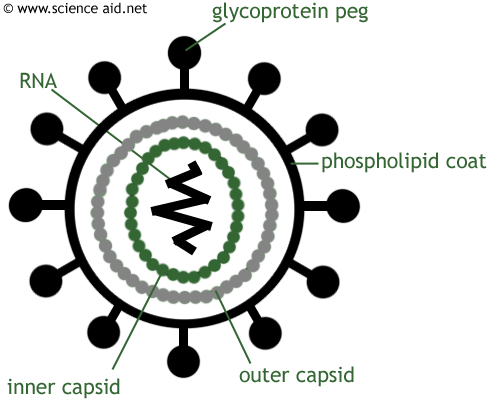Viruses and Infection
Structure
Viruses are very small, much smaller than bacteria. They range from 20 to 300nm, whereas bacteria are commonly in the range 2 to 5µm (2000 to 5000nm). Below is the structure of the human immunodeficiency virus (HIV). Influenza is different to the HIV in that it has no inner capdid or knobs on the glycoprotein pegs.

Here are the functions of the various structures in the diagram.
| Feature | Function |
|---|---|
| RNA | Genetic material - about 10 000 to 200 000 nucleotides compared to 3 200 000 000 in humans. |
| Capsid | Encloses and protects the genetic material, made of capsomeres that link together to form one of two geometric structures. |
| Coat | Derived from the membrane of the host cell and helps the virus penertrate the host's cell membrane - not present in all viruses. |
Transmission of Viruses
Influenza or flu is a virus that is very common, but musn't be mistaken with the less harmful common cold. Influenza is transmitted in droplets in human breathe, that are breathed in, the virus then can infect tissue in the upper respiratory tract. The virus incubates in the host cells for 3 days - when it bursts out, toxins are relased that cause the symptoms of fever, headache, body aches, and tiredness. It can be fatal in the elderly if secondary infection occurs, where bacteria take advantage of the weakened immunity.
HIV is a virus that enters T-lymphocyte cells in the blood. It is transmitted by sexual activity here infected semen or vaginal secretions enter the blood in small lesions. HIV can also be transmitted by using infected needles for injecting drugs. HIV usually leads to AIDS (acquired immune deficiency syndrome) where the HIV infects and destroys the T-lymphocytes so the immune system is impaired. AIDS patients will die from infections such as pneumonia since they have no defence from it.
The life cycle of a virus as it replicates in the host cell is shown in the diagram below.

In summary: the virus is a piece of genetic material that uses host cells to create copies of itself - in so doing, destroying the host's cells.
Avoiding Viral Disease
It is difficult to treat viral infections because they have no metabolism of their own, so antibiotics will not work; and it would be difficult to destroy the virus without destroying the host cell as well. Medicines given for viral infections will target symptoms, so aspirin or paracetemol.
The influenza virus can be prevented by vaccination, and every year governments target the elderly and those with relevant chronic illnesses (like asmatha) to protect them. The vaccine changes every year to take account of the most likely strain of influenza that year.
Because of its effects, especially in Africa, preventing HIV spreading is a big issue. Safe sex means using a condom that prevents body fluids being exchanged. Its spread in drugs users is prevented by offering clean needles to drug users - an approach that seems to have had some effect.
